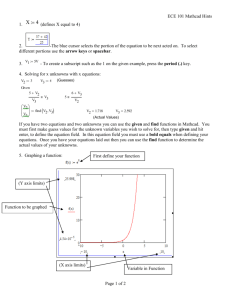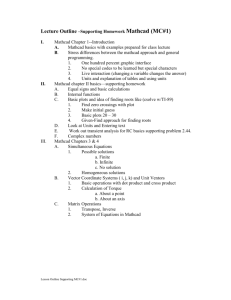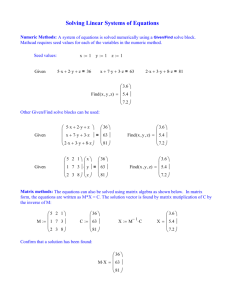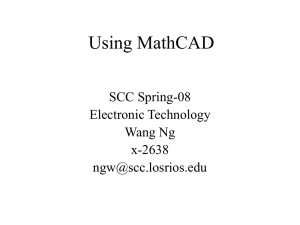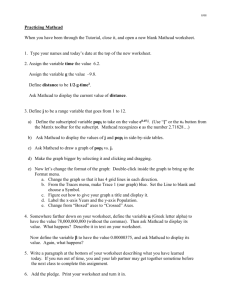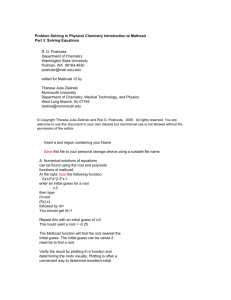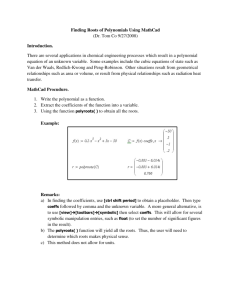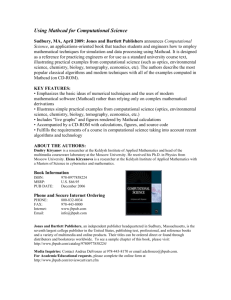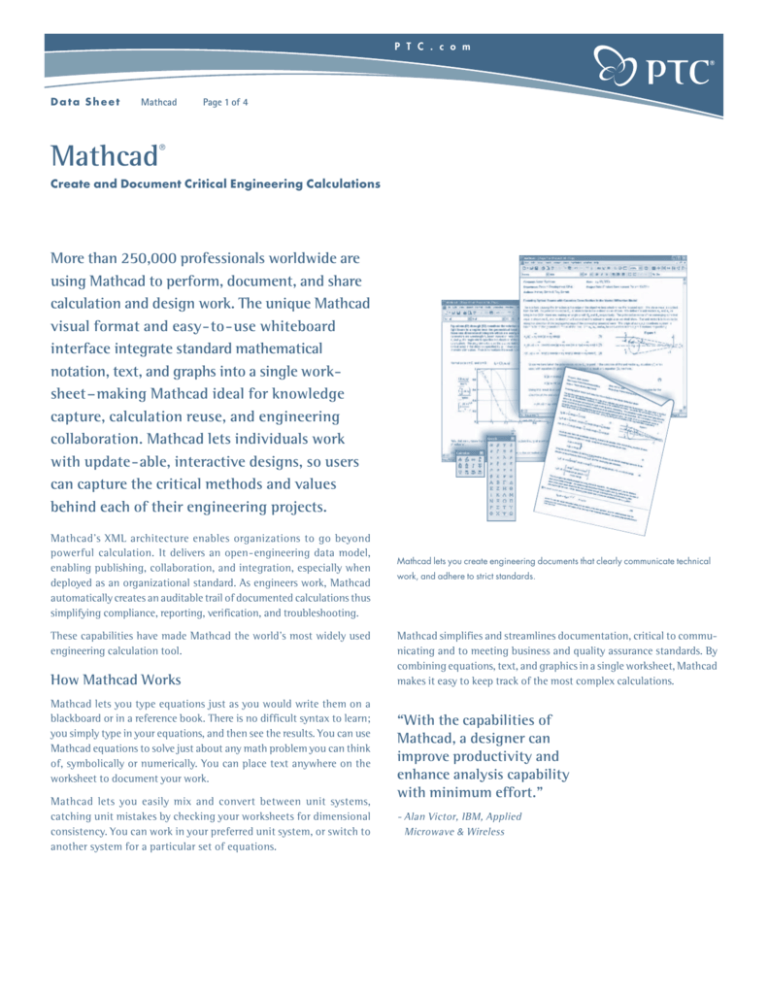
P T C . c o m
Data Sheet
Mathcad
Mathcad
Page 1 of 4
®
Create and Document Critical Engineering Calculations
More than 250,000 professionals worldwide are
using Mathcad to perform, document, and share
calculation and design work. The unique Mathcad
visual format and easy-to-use whiteboard
interface integrate standard mathematical
notation, text, and graphs into a single worksheet–making Mathcad ideal for knowledge
capture, calculation reuse, and engineering
collaboration. Mathcad lets individuals work
with update-able, interactive designs, so users
can capture the critical methods and values
behind each of their engineering projects.
Mathcad’s XML architecture enables organizations to go beyond
powerful calculation. It delivers an open-engineering data model,
enabling publishing, collaboration, and integration, especially when
deployed as an organizational standard. As engineers work, Mathcad
automatically creates an auditable trail of documented calculations thus
simplifying compliance, reporting, verification, and troubleshooting.
These capabilities have made Mathcad the world’s most widely used
engineering calculation tool.
How Mathcad Works
Mathcad lets you type equations just as you would write them on a
blackboard or in a reference book. There is no difficult syntax to learn;
you simply type in your equations, and then see the results. You can use
Mathcad equations to solve just about any math problem you can think
of, symbolically or numerically. You can place text anywhere on the
worksheet to document your work.
Mathcad lets you easily mix and convert between unit systems,
catching unit mistakes by checking your worksheets for dimensional
consistency. You can work in your preferred unit system, or switch to
another system for a particular set of equations.
Mathcad lets you create engineering documents that clearly communicate technical
work, and adhere to strict standards.
Mathcad simplifies and streamlines documentation, critical to communicating and to meeting business and quality assurance standards. By
combining equations, text, and graphics in a single worksheet, Mathcad
makes it easy to keep track of the most complex calculations.
“With the capabilities of
Mathcad, a designer can
improve productivity and
enhance analysis capability
with minimum effort.”
- Alan Victor, IBM, Applied
Microwave & Wireless
P T C . c o m
Data Sheet
Mathcad
Page 2 of 4
Key Features and Benefits
Feature Details
• Calculate, model, and visualize your technical ideas while
reducing errors
• Math formats and display:
• Update interactive designs for instant results
• Document your calculations using unit-aware math notation
• Graph and plot your work instantly with built-in 2D and
3D graphing tools
• Verify, visualize, and annotate your solutions for all
engineering disciplines
• Integrate your data across applications and systems
• Publish your results using a wide variety of output formats
• Reduce errors in your work with automatic unit checking
• Set your own default unit system and create your own units
- Real, imaginary, and complex number support
- Decimal, binary, octal, and hexadecimal formats
- Over 200 built-in units with user-defined default options
- Support for creating user-defined unit systems
- Engineering and scientific notation display
- Mixed integer display
- Explicit calculations enable variables to be displayed in the
equations as defined values, improving visual audit and
review of calculations
• Live math and symbolics capabilities:
• Automate your operations with templates and stylesheets
- Define and evaluate variables and functions numerically
or symbolically
• Import and export data easily
- Manipulate, transform, and extract information from matrices
• Integrate with Pro/ENGINEER® to realize unique predictive
engineering capabilities
- Expand, factor, and simplify expressions algebraically
Computational Capabilities
• High-end numerics: Perform summations, products, derivatives,
integrals, and Boolean operations; apply trigonometric, exponential,
hyperbolic, and other functions and transforms.
• Live symbolics: Simplify, differentiate, integrate, and transform
expressions algebraically; Mathcad’s patented live symbolics
technology automatically recalculates algebraic solutions and
allows you to use them in subsequent calculations.
• Vector and matrix handling: Manipulate arrays and perform
various linear algebra operations, such as finding eigenvalues
and eigenvectors.
• Statistics and data analysis: Generate random numbers, calculate
histograms, fit data to built-in and general functions, interpolate
data, and build probability distribution models.
• Differential equation solving: Solve ordinary and partial differential
equations, systems of differential equations, and boundary value
problems, both at the command line and in solve blocks that use
natural notation to specify the differential equations and constraints.
• Units support: Include units in calculations, perform unit conversions
and automatically check dimensions. Add domain specific units.
Convert results to any unit system or custom values.
• Built-in operators:
- More than 17 arithmetic operators, 12 vector and matrix operators,
and 5 summation and product operators
- 2 derivative operators and 5 integration and limit operators
- 9 evaluation operators
- 10 Boolean operators
- Customized, user-defined operator support
- Arithmetic operations are IEEE-adherent
• Graphing and visualization:
- Standard engineering plot-types: x-y plots, a secondary y-axis,
polar plots, bar charts, vector, contour, scatter, and surface plots
- 2D and 3D QuickPlot™ and plot annotation capabilities
- Interactive plot zoom data point selection, and 3D
angle adjustment
- Detailed plot formatting for numbers, ticks, labels, line types,
markers, etc.
- Image viewer with support for BMP, GIF, JPG, PCX, TARGA,
PGM, TIFF
- Image manipulation (zoom/pan/crop, brightness/contrast,
rotate/flip/transpose, etc.)
P T C . c o m
Data Sheet
Mathcad
Page 3 of 4
• Built-in functions:
- 80+ core mathematical functions and 10 discrete
transform functions
- 110+ statistics, probability, and data analysis functions
- 18 differential equation and partial differential equation solvers
- 28 file access functions
- 14 expression-type and string functions
- 18 finance functions
- 13 symbolic functions, including numer and denom,
for algebraic calculations
• Application customization and extensibility:
- Native XML file format for simple integration
- Ability to add user-created functions created in C or C++
- Embed, link, and automate any OLE-compliant application or
ActiveX control in Mathcad using VBScript™ or JScript™
- Use OLE Automation & Visual Basic® to develop solutions
incorporating Mathcad computations
- New Software development kit (SDK) for building custom C++
components for integrating with third-party applications
inside Mathcad
- Support for setting user’s own function libraries
• Solving capabilities:
- 7 built-in functions for system solving and root-finding
- 18 built-in functions for solving ordinary differential equations
and partial differential equations
- Solve block notation for solving systems of linear, nonlinear, and
differential equations in natural notation, along with constraints
- Programming and parameterization for repeated solutions
• Document/text editing features:
- Customizable spell checker with technical terms database
- Document templates and stylesheets
- Hyperlinking
- Hide, collapse, and password lock
- Support for UNICODE
- Right-click menu for inserting math regions into text regions
- Drag-select a series of regions simultaneously
• Usability features:
- Automatic recalculation
- Easy-to-use equation editor
- Error tracing and redefinition warnings
- Multi-step undo
- Flexible data import features, supporting text and numerical
entries, engineering format, real and complex data, cut and
paste, and import from a wide variety of file formats (Excel,
fixed width, binary, etc.)
- Enhanced error messages clarify source of problems
- Program debugging capabilities
- Comprehensive units support
- Autosave function
• File formats, publishing, and Web support:
- Save as HTML, XHTML, and RTF formats
- Can be converted to Adobe Acrobat® PDF
- HTTP file open support
- Publish worksheets to the Mathcad Calculation Server
• Data exchange features:
- Native XML file format for simple data exchange
- Data Import Wizard
- Data import for .mat files, Excel files, Lotus 1-2-3,
ASCII, binary, and others
- Microsoft® Access, FoxPro, and SQL-supported databases
as well as ODBC connectivity
- Enhanced Excel data exchange and integration
• Integration with Pro/ENGINEER
- Bidirectional integration enables efficient and accurate data
exchange between applications
- Supports dynamic, live updates to calculations and CAD models
- Values or results of calculations performed in Mathcad drive
parameters and dimensions in the CAD model
- CAD parameters and dimensions can be sent to Mathcad as inputs
to calculations
P T C . c o m
Data Sheet
Mathcad
Page 4 of 4
• Connectivity with other applications, including:
Server Requirements for Volume License Deployment
- National Instruments® LabVIEW™
Requirements for Mathcad network installations Macrovision®
FLEXlm® requirements (licensing management solution):
• PC with Pentium/Celeron, 300 MHz or higher,
400+ MHz recommended
- Bentley Microstation®
• Windows 2000 SP4, XP or later
- ANSYS Workbench™
• At least 150 MB of hard disk space
- Microsoft® Excel and PowerPoint
- MathWorks MATLAB®
• Resources:
• CD-ROM or DVD drive
- References tables, key formulas, and constants
• SVGA or higher graphics card and monitor
- Technical support knowledgebase
• Mouse or compatible pointing device
- Detailed tutorials across all Mathcad functionality
Macrovision® FLEXlm® requirements (software license management
for an organization’s user base):
• Windows 2000 SP4, XP or later
- Easy-to-use online help with Search and Index
- More than 300 QuickSheets for standard analyses and tasks
- 11 language dictionaries
- User forums and Web Library
• 16 MB free memory (for license management process)
• 9 MB of hard disk space (not including log file)
• CD-ROM or DVD drive
Specifications
• SVGA or higher graphics card and monitor
Client Hardware Requirements
• Mouse or compatible pointing device
• Pentium/Celeron processor, 400 MHz or higher;
700+ MHz recommended
For More Information
• 256 MB of RAM; 512 MB or more recommended
For more information on Mathcad, visit www.ptc.com/mathcad.
• 550 MB of hard disk space (250 MB for Mathcad, 100 MB for
prerequisites, 200 MB temporary space during installation)
• CD-ROM or DVD drive (for CD installation only)
• SVGA or higher graphics card and monitor
• Mouse or compatible pointing device
Client Software Requirements
• Windows 2000 SP4, Windows XP SP2 or later
©2006, Parametric Technology Corporation (PTC). All rights reserved. Information described herein is
furnished for informational use only, is subject to change without notice, and should not be construed as
a guarantee, commitment, condition, or offer by PTC. PTC, the logo, Pro/ENGINEER, Arbortext, and all
PTC product names and logos are trademarks or registered trademarks of PTC and/or its subsidiaries in
the United States and in other countries. All other product or company names are property of their
respective owners.
2134-Mathcad-DS-1006

